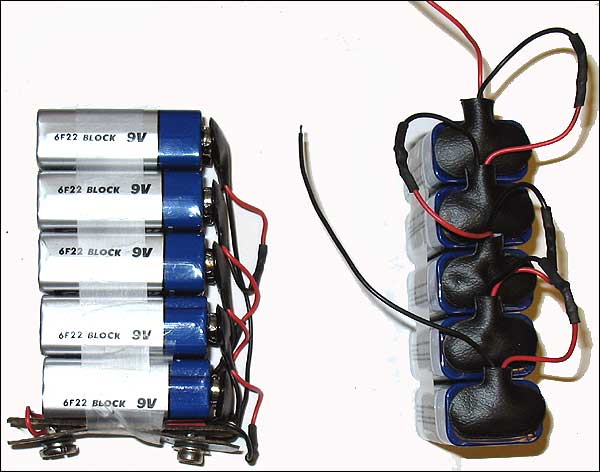 |
Many test sets such as the KS-21250 L1 Portable Coin Test Set and the common kick meter, Brownie or KS-8455 use the KS-14369 45 volt battery or B cell. These can be hard to obtain nowadays, and will get harder to get in the future. They won't get any less expensive, either. Prepare for the future. Make an easy to maintain replacement battery pack today! |
These batteries are easy to make a replacement for. By carefully slitting the old battery's cardboard wrapper, and removing the old cells, saving the wrapper, connector and its ribbon leads and the insulator from the other end, one can rebuild this battery using common 9 volt batteries. All you will need is some rosin core solder, 5 - 9 volt battery clips (may be obtained from some eBay sellers 50 for $5 or, as Jim Schultz says, for the truly thrifty, you can harvest the terminals off dead 9 volt batteries), 5 - 9 volt batteries, shrink wrap tubing, small quantity of scotch tape, and time on your hands.

Battery with connector attached Detail of cell wiring The batteries are first stacked as seen above, then taped to hold them in place. The snaps are then pressed onto all 5 batteries. All but the first and last leads are cut to about 1/2 their length. Then, one by one, each battery (cell) red or positive lead is soldered to the black or negative lead of the cell ahead of it. Prior to soldering, a 3/4 inch section of shrink wrap tubing is placed on one of the two leads to be soldered. Once soldered, the tubing can be slipped over the joint and shrunk. This is continued down the line till you reach the last lead.
This is where the old terminal section you saved from the original battery comes into use. The serrated connector is positive. Connect your red lead to it. The unserrated connector is negative - solder your black lead to it. Connections may be made to the ribbon lead saved along with the connector, or directly to the metal of the terminal. This should be sandwiched with the insulator taken from the other end of the old battery, and then taped to the new battery pack as shown above left. The cells I used are plastic coated, but not all are - if you have circuitry near the battery which could contact the sides of any of the cells, you should insulate the battery from contacting it by using an insulating barrier or by surrounding the cells with cardboard or the original battery's cover.
Total cost should be minimal, and it carries the advantage of allowing you to replace the individual cells within the battery.
If care is taken in cutting apart the old battery, this assembly can be finessed back into the old wrapper. It is tight, and will produce a battery slightly thicker than the original - but will please those who like to retain things as close to original as possible.
Original type batteries may be found under the following names and models: NEDA 201, Eveready 455 with prices beginning at a low of $20, and going uphill from there. One such source is BatteryCountry.com - http://www.batterycountry.com/ShopSite/specialty-cell.html. The whole point of this exersize is to show that there is always a way to make a satisfactory replacement for a device, as original types will probably not be available much longer. Thanks to batteries assembled this way, both my kick meter and coin test set are 100% operational, with no modification to the original test set.